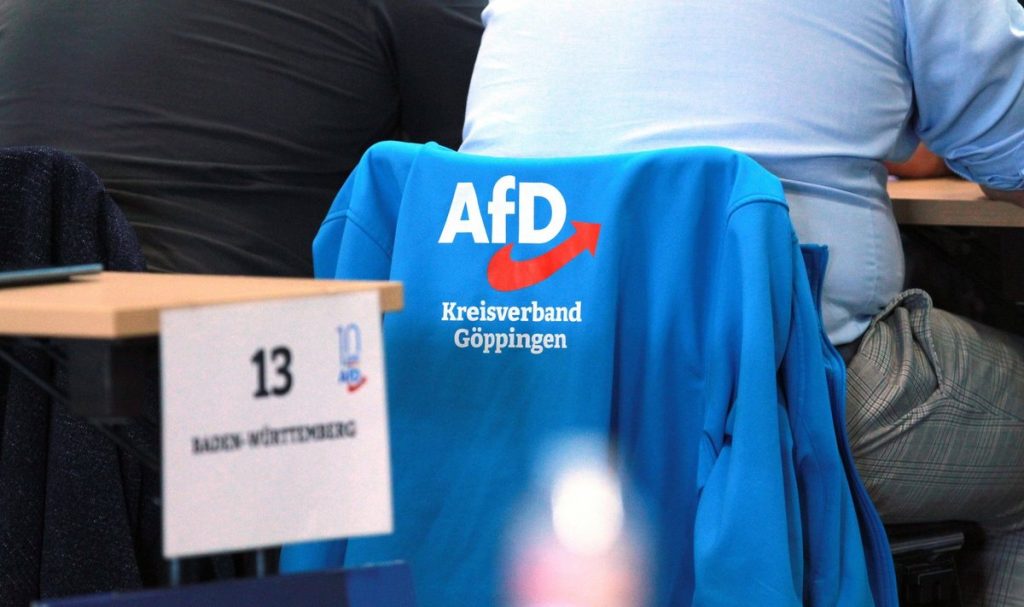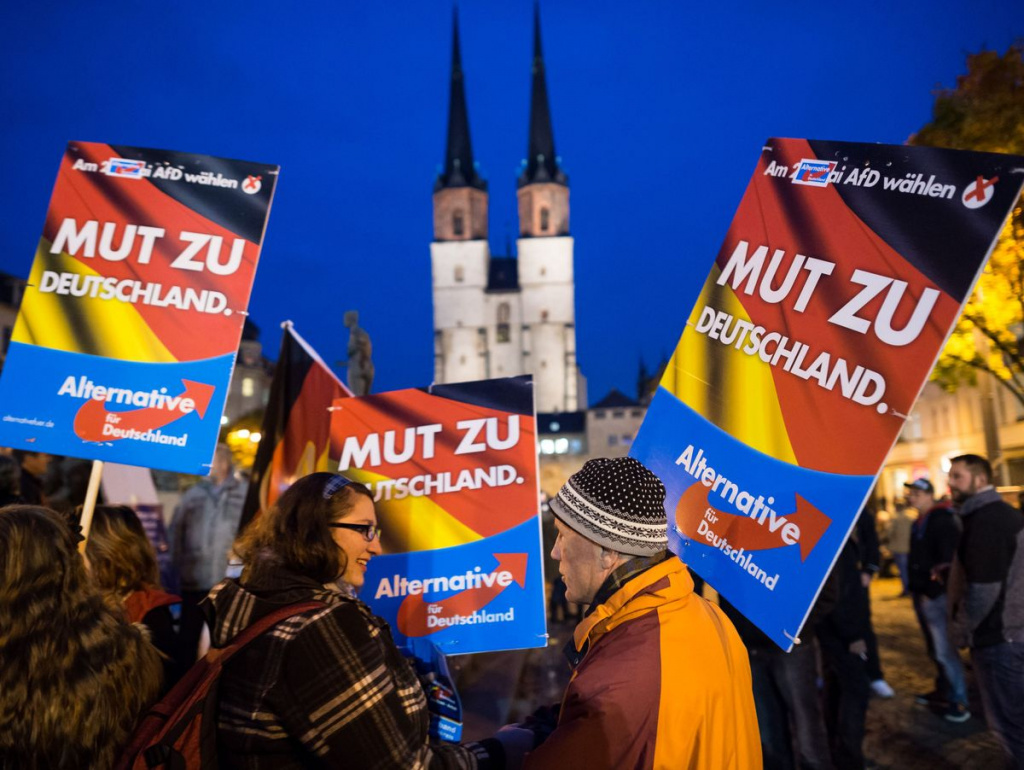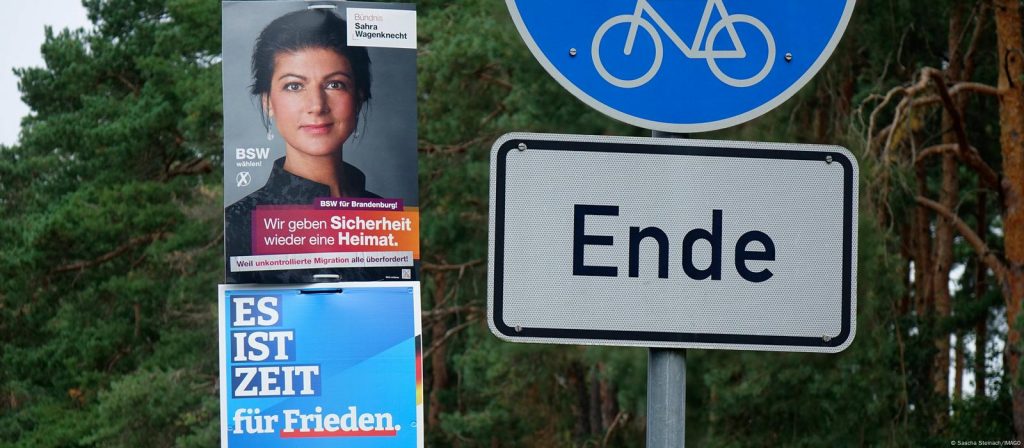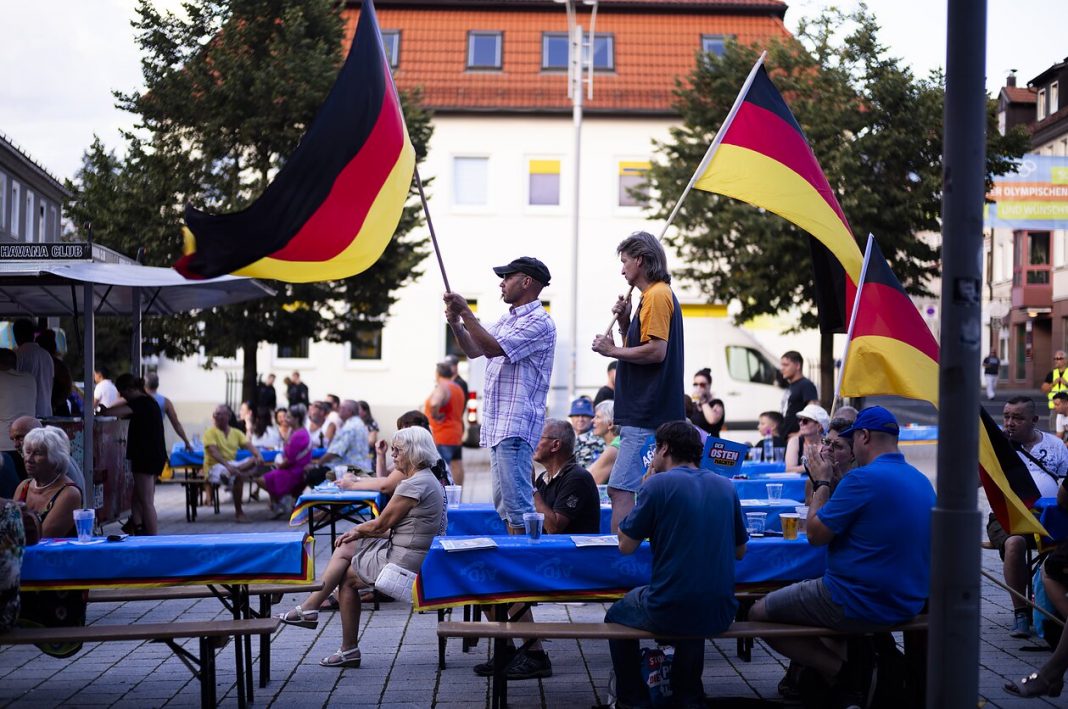Not a single land election in Germany has caused such excitement and a cascade of political forecasts as the one held on 1 September in the eastern German states of Thuringia and Saxony, as well as the one to be held soon in Brandenburg. These elections have been awaited and talked about all year, labelled both ‘momentous’ and ‘pivotal’ for all Germans. In the media field, they have temporarily pushed aside all other events.
In Erfurt, the main city of Thuringia, more than 700 media representatives were accredited on the day of voting, which once again emphasised the extraordinary nature of the election results. As DW notes, according to preliminary data, for the first time in the history of its existence, the far-right party Alternative for Germany won with 32.8 per cent of the vote. Second place went to the conservative Christian Democratic Union (CDU), which won 23.6 per cent. Third was the left-populist party founded in January 2024, Sarah Wagenknecht’s Union for Common Sense and Justice (BSW) with 15.8 per cent. The Left Party came fourth with 13.1 per cent, while the German Social Democratic Party (SPD), the ruling Social Democratic Party of Germany (SPD), came fifth with 6.1 per cent. The Union-90/Greens (3.2 per cent of the vote) and the Free Democratic Party (FDP) (1.1 per cent), part of the federal ruling coalition, did not make it into the state parliament. The turnout in the Thuringian elections was 73.6 per cent. Thus, 32 seats in the regional parliament will go to the AdG, 23 to the CDU, 15 to the FDP, 12 to the Left and 6 to the SPD. At least 45 deputies are needed to form a governing coalition in Thuringia.
In Saxony, which neighbours Thuringia, the CDU conservatives had the best result in the land elections. They managed to gain 31.9 per cent of the votes of local voters. The second result here went to the AdG (30.6 per cent), followed by the Sarah Wagenknecht Union (11.8 per cent). The SPD (7.3 per cent), the Greens (5.1 per cent) and the Left (4.5 per cent) finished next. The turnout in this election was 74.4 per cent. The seats in parliament will be distributed as follows: CDU will get 42 mandates, AdG 40, SSV 15, SPD 10, Greens 7 and the Left 6. In order to form a coalition, at least 61 deputies are needed.
In fact, the results of the land elections were not a revelation to anyone. The success in the east of the country of the Alternative for Germany and the left-wing populist Sarah Wagenknecht Union (BSW) was predictable. Let us try to understand the reasons for the triumph of the extreme right and ultra-left, the weakening of the positions of the parties of the ‘traffic light coalition’, and how the elections in Thuringia and Saxony will affect the domestic and foreign policy of Germany.
In this piece, Ascolta analyses the results of the land elections held in the two German states last weekend. It also looks not only at the results and consequences of the elections themselves, but also at the origins of the rise of right-wing views and the prospects for their further development in Germany.
This Content Is Only For Subscribers
Elections and illegals

On the eve of the elections there was an event that, in fact, ‘covered’ the whole of Germany. The celebration of the 650th anniversary of the city in the German city of Solingen turned into a tragedy. In the middle of the ‘Festival of Diversity’ timed to the commemorative date in one of the central squares of the city, an unknown man with a knife attacked the gathered people. He squeezed into the crowd and began waving the knife, aiming for people’s throats. According to eyewitnesses, the nightmare lasted several minutes, and then the terrorist disappeared, leaving three dead and eight wounded at the scene.
The attacker turned out to be a 26-year-old Syrian man who had sought asylum in Germany and was allegedly linked to the Islamic State terrorist group. After the tragedy, Prime Minister Olaf Scholz visited Solingen, where he honoured the memory of those killed and promised to tighten gun laws and speed up the deportation of illegal migrants. The massacre in Solingen, has once again brought the topic of illegal migration to the forefront with renewed vigour. Chancellor Olaf Scholz announced imminent ‘confidential and targeted talks’ with representatives of other parties and agencies on the topic of ‘further reducing illegal migration to Germany.’
‘The government will deport Syrian and Afghan refugees who have committed serious crimes, crack down hard on illegal immigration and fight terrorism with all its might and with all its severity,’ the chancellor firmly pledged at a campaign rally in Jena (Thuringia). The ministers in turn proposed classifying knife offences as a reason for deportation, including to Syria and Afghanistan; withdrawing benefits for asylum seekers who, according to the state, should seek protection in the EU country they first entered under the Dublin Convention; and withdrawing protected status for refugees who leave Germany to visit their home countries without a valid reason. By cutting benefits for such cases, the coalition hopes to reduce migration rates.
Olaf Scholz, leader of the ruling Social Democrats, discussed the attack in Solingen with Friedrich Merz, leader of the conservative opposition Christian Democratic Union (CDU) party. And the latter offered Mr Scholz parliamentary support to push through a bill tightening migration policy. Mr Merz allowed the possibility of declaring a state of emergency in the country so that Berlin could bypass a Europe-wide law and return the migrants to the first EU country they arrived in. Jens Spahn, vice-chairman of the CDU parliamentary faction, suggested closing the country’s borders altogether. This is the first time since 2021, when the Taliban came to power, that Germany has deported Afghan citizens back to their homeland.
To a large extent, the desire of both the Social Democrats and the centre-right CDU to finally move away from the once liberal migration policy is motivated by electoral considerations, as elections to the Landtags are scheduled for September 1 in Thuringia and Saxony. However, as we can see from their results, the attempt of the parties of the ‘traffic light coalition’ to ‘ride’ the ‘migration’ agenda and earn themselves additional electoral bonuses was not successful. The Solingen tragedy certainly strengthened the anti-immigrant AdG’s position, but it was by no means the only factor in its success.
AdG: leaving the ‘political ghetto’

The consequences of the pandemic and full-scale war in Ukraine, as well as dissatisfaction with the government coalition at the federal level, are forcing citizens to vote for new parties on the German political landscape.
The AdG is a relatively new political force in Germany and combines Euroscepticism with an anti-migration stance. It began its climb up the political ladder in 2017 on the wave of the European migration crisis in 2015-2016 and achieved its first successes by becoming Germany’s third party. Time passed, Germans became concerned about other issues and the AdG went back into the shadows. Today, Alternative for Germany has 77 out of 773 parliamentary seats and is the fifth party in the Bundestag. However, since the last federal election in 2021, it has been one of the beneficiaries of falling support for Chancellor Olaf Scholz’s three-party ruling coalition, which has fallen to a record low.
At the same time, the ‘Alternative for Germany’ is popular not only in the east of Germany, but also in its western part. Thus in the land elections in Bavaria and Hesse in 2023, it came second with 14.6 per cent and 18.8 per cent respectively, behind only the CSU and CDU. The local parliamentary elections then marked new trends. Firstly, voting in the states where about a quarter of the population of Germany lives revealed an obvious growth of conservative sentiments among the electorate. Secondly, there was a serious failure of all three parties from the ruling federal coalition.
Electoral fatigue from the old parties, playing on social fears from the decline in economic rates, the consequences of increased migration and the policy of ‘green transition’ became the reason for the popularity of the ‘Alternative for Germany’. The success of the AdG has alarmed official Berlin. A whole anti-right-wing campaign was launched in Germany. Germany witnessed large-scale protests held under the slogans: ‘Let’s protect democracy’, ‘There is no place for Nazis’. More than 300,000 people took part in one of the actions. In the elections to the European Parliament, the electoral ‘trick’ of many German parties was the fight against the ‘right-wing threat’ represented by the Alternative for Germany party. Olaf Scholz not only supported on his Twitter (X) the many thousands of German protests against the far-right that swept across the country during the winter, but also took part in one of the demonstrations in Potsdam. The topic of the ‘far-right threat’ has not fallen off the ‘agenda’ of the Chancellor and the SPD at any state and party events. The purpose of these actions was to create the effect of widespread dissatisfaction with the AdG in public opinion, to show that the party had no support in the western and even eastern states and that people perceived it as an ‘extremist’ force that should be banned.
However, the pressure from the authorities only made the party stronger. Amidst a series of scandals involving espionage, exposure to foreign influence, and accusations of Nazi sympathies, the Alternative for Germany pushed Olaf Scholz’s Social Democrats into third place in the European Parliament elections with 15.9 per cent of the vote and 14 MEPs in the ‘Europe of Sovereign Nations’ political group. The AdG’s influence was particularly evident in East Germany, where it became the main party at all, gaining 27 per cent and ahead of the CDU, which leads the all-German vote by 7 per cent. Almost 35 years after the fall of the Berlin Wall, a political divide has once again run through the country, drawing the former border between East and West Germany. And on the eastern side of the divide, the gaining strength of the ‘Alternative for Germany’ has settled in.
The secret of the far-right’s popularity in the eastern states, populated predominantly by former GDR citizens, has been discussed many times. Despite the fact that more than three decades have passed since the reunification of Germany, the differences between the east and west of the country remain very tangible. This applies to the living standards of Germans, their incomes, psychology and mentality, and social composition. And although the German authorities after reunification have spent considerable sums on levelling the differences in the life of the population of the former ‘two Germanies’, ‘East Germans’ still feel themselves as Germans of the second category.
Researchers at the YouGove Institute recently found that 60 per cent of East Germans are fully or partially convinced that living conditions in West Germany are significantly better than in East Germany. In addition, 77 per cent of those surveyed in Saxony, Thuringia and Brandenburg believe that West Germans are prejudiced against them. And the Alternative has learnt to play subtly on these contradictions and use them in its political rhetoric. The AdG also works a lot with young people. It has managed to package its right-wing ideology in forms that appeal to young people with humour and music, spreading its ideas in social networks – TikTok, Facebook, YouTube. To this end, the AdG also practices youth folk festivals – with beer, barbecue or coffee – where a sense of unity is formed.

This is especially true when it comes to the hot topic of migrants, who have flooded the country and disrupted the world of Germans. Foreign culture has become part of many cityscapes. Oriental tea shops, hookah lounges, Arab grocery shops and, in some places, new mosques have begun to appear on German streets. In 2015, two million refugees from Syria and Iraq arrived in Europe, most of them in Germany, and the AdG became the main political force actively defending the German identity and way of life. The debate on asylum and migrants in Germany intensified after the outbreak of the Russian-Ukrainian war in 2022, when a new wave of refugees – from Ukraine – poured into Germany. The AdG party regained points in its anti-migrant rhetoric and began to gradually regain lost ground. However, by fuelling animosity towards migrants, it came under the control of the Federal Office for the Protection of the Constitution (BfV). Today it classifies the regional branches of the AdG in Thuringia and Saxony as ‘staunchly right-wing extremist’, while in Brandenburg the AdG is being monitored due to ‘suspicion of right-wing extremism’.
But it is not only the hardline migration policy that attracts East Germans to the AdG. One of the frustrations is economic problems. Optimism that Germany will recover in 2024, after nearly two years of zero growth, has faded as the expected jump in consumer spending has not materialised. The country’s industrial sector continues to struggle, feeling a lack of investment in basic infrastructure. As Bloomberg notes, the pension and medical systems are chronically underfunded. There are not enough teachers and kindergarten teachers.
Polls show that people are voting for the AdG in regions affected by the changes. For example, in areas where there are car factories that will switch from internal combustion engines to electric or in areas that have long depended on lignite and hard coal mining. The AdG is therefore opposed to a green transition policy. The party also proposes a referendum on abandoning the euro and restoring the old German currency. The problems facing the world’s third largest economy and the current government’s inability to offer effective solutions is prompting many to vote for the AdG.
A distinctive feature of the current election campaign in eastern Germany is the active influence of foreign policy issues on its course, although these are usually out of the focus of the land elections as they are the responsibility of the federal cabinet. Russia’s war against Ukraine has become almost the main topic of the campaign. Arms deliveries to Ukraine, which are opposed by many in East Germany, were discussed. There were calls for immediate peace talks. In fact, the mood of East Germans is in line with the AdG’s programme statements. It should be recalled that the AdG demanded to stop supplying arms to Ukraine, to lift sanctions against Russia and to resume co-operation with it, for which it received the image of a ‘pro-Russian party’.
Björn Hecke, head of the AdG branch in Thuringia, said that the election results would make it clear whether Germany would ‘get off the warpath in the medium term’ or continue to take actions leading to the escalation of the conflict. Björn Höcke is one of the most scandalised politicians in the party’s ranks. The German secret service (Office for the Protection of the Constitution) has placed them under surveillance, a court has officially authorised Höcke to be called a ‘fascist’, and the politician has been fined for using the SA storm troop slogan ‘All for Germany’ (‘Alles für Deutschland’). If Hecke were to become chancellor, he promised to make his first visit to Moscow. However, despite massive support for the AdG, its leader and the top candidate of the Thuringian branch lost his majority constituency to the CDU candidate in the land elections. However, despite the setback, he made it to the Land Parliament on the party list as the AdG’s top candidate.
For the AdG, consolidating its position in the eastern German states is part of a larger strategy: to start by winning municipalities and state parliaments throughout the east. Such dominance, experts believe, will stabilise the party and allow it to expand to the highest levels of national government one day. It’s no secret that the successes of far-right parties in Europe have most often been attributed to protesting voters who express distrust of mainstream parties. But in eastern Germany, it seems that voters are increasingly supporting the AdG not only because of protest, but also because of political conviction. One in two AdG voters in Thuringia and Saxony voted for the party because they trust it. This is a major breakthrough compared to previous elections.

Moreover, according to polls in both Länder, voters said Alternative for Germany would best represent the interests of people in East Germany and implement an effective anti-immigration policy. On other issues, including social protection and fighting crime, the party ranked among the top two parties in terms of voter confidence. Thus, the AdG has so strengthened its position in eastern Germany that Germans call it the ‘people’s party,’ a title that until recently was reserved only for the two main parties, such as the SPD and CDU.
The AdG now faces a dramatic period of coalition-building ahead. The reality today is that despite impressive results in Thuringia and Saxony the party is unlikely to come to power. The leaders of the parties that made it to the Landtag, including the ‘Sarah Wagenknet Union’, have ruled out co-operation with the AdG. They have formed a ‘cordon sanitaire’ or, as they say in Germany, a ‘firewall’ around the political force similar to the one French President Emmanuel Macron put up around Marine Le Pen’s National Union and refuse to include it in coalition governments – or, for that matter, to co-operate with the party in passing any kind of legislation.
Despite this, in Thuringia, the AdG is being given special ‘blocking minority’ rights, which will allow it to veto some important decisions in the state legislature. It will be able to block early elections, the election of judges to the state Constitutional Court or changes to Thuringia’s constitution. However, the AdG leaders are not going to give up and will try to break down this wall by making it impossible to avoid co-operation with the party in smaller towns. If elected representatives need to co-operate with the AdG on mundane tasks such as repairing roads and schools, they argue, then the major parties will one day be forced to work with the party on larger political issues. And that strategy is working. As Politico notes, between 2019 and 2023, there have been more than 120 cases of co-operation in local government between Alternative for Germany and the mainstream parties, most often with the CDU. Examples of such cooperation include a case in Saxony, where the mainstream parties in one city council supported an AdG proposal to ban the use of gender-neutral language in city theatre advertisements. In another case in Thuringia, the main parties supported an AdG proposal to hold a vote on the dismissal of a left-wing mayor.
After the Alternative for Germany victory in Thuringia, Hecke said he was ready to take responsibility for forming a government. ‘There is a good parliamentary tradition in Germany, according to which the strongest force invites others to talks after the election. Next week we will hold talks in the party bodies, analyse the situation. And then we will decide to whom we will offer these proposals for discussion,’ summarised the AdG’s main candidate.
According to a poll by the social and legal media company ARD, 37 per cent of respondents in Thuringia consider AdG participation in government a viable option, while 60 per cent do not. AdG co-chair Alice Weidel claims her party should be represented in the governments in Thuringia and Saxony. ‘The voter wants the AdG to be involved in government. 30 per cent of the voters in both federal states voted for us each, and without us a stable government is not possible at all.’ Therefore, experts say, the AdG is likely to resort to manoeuvres to ensure that it cannot be prevented from taking power as an undemocratic force.
At present, the coalition maths is such that, for example, in Thuringia, the following options exist: CDU + BSW + SPD, according to preliminary data – this is about 45% of the seats in the Landtag (88 in total); such a composition would be extremely difficult due to ideological differences between the participants, but it is nevertheless a way for the CDU to form a government; the other option is BSW + Left + SPD – in theory such a coalition could be formed, but it too would require significant compromises and is unlikely to be stable, especially as it only has about 35% of the seats. In Saxony there are three options for a coalition: CDU + BSW + SPD – the most likely scenario (51 per cent of 120 seats); CDU + BSW + Greens – a slightly less likely scenario (around 49 per cent); CDU + BSW – a minimum number of seats (around 44 per cent). All three Saxon options also with significant risks of disagreement on key issues. However, the chances are there and the Christian Democrats may try to capitalise on them.
‘Leftists’

Another winner of the land elections in Thuringia and Saxony can safely be called the ultra-leftist party ‘Sarah Wagenknecht’s Union – Common Sense and Justice’ (BSW). Despite the fact that this political force came third in both states with 15.8 per cent and 11.5 per cent respectively, these results are a real success for the young party, which was only ‘born’ at the beginning of 2024.
Born in Thuringia, Sarah Wagenknecht began her political career as a member of the Socialist United Party of Germany (SED) at the end of the German Democratic Republic. It was the SED that was later transformed into the Party of Democratic Socialism, the predecessor of the Left. In the Left’s modern history, Wagenknecht was both the party’s deputy chairman (2010-2014) and faction leader in the Bundestag (2015-2019). However, in recent years, tensions between the politician and the party have been increasingly growing. As a result, Sarah Wagenknecht left the Left Party (Die Linke) and in October 2023 established her own political party, the Sarah Wagenknecht Union for Reason and Justice (BSW).
The new political project began its trial run in the June European Parliament elections, where it won 6.2 per cent of the vote and won six seats in the EP. In East Germany, BSW’s popularity was even higher, with around 13 per cent of the vote, making it the third party behind the AdG and CDU. ‘Sarah Wagenknecht’s Union’ attracts voters with populist slogans that everyone understands – for greater social justice, higher pensions and wages, and higher taxes on Germany’s rich. The BSW leader also considers the German government’s climate policy, in particular the decision to ban the production of cars with internal combustion engines (ICE) as early as 2035, to be a mistake. Instead of a ban, Wagenknecht says, it should have encouraged car companies to produce more fuel-efficient internal combustion engines.
Although the party is considered to be ultra-left, it is on the far right when it comes to migration policy, demanding that the influx of migrants be limited to a level, the BSW party programme says, ‘that would not exceed the capacity of our country and its infrastructure’.
In this way, the Wagenknecht party has entered the traditional field of both ‘alternativeists’ and leftists, drawing some of their former supporters to its side. But in this election campaign the ‘Sarah Wagenknecht Union’ paid special attention to the issues of foreign policy, and more precisely to Russia’s war against Ukraine. In an interview with Deutschlandfunk radio in July, Wagenknecht said that ‘the elections in the east are also a referendum on war and peace.’ She said voters expect her to make sure that the risk of Germany becoming involved in war does not increase. In addition, Wagenknecht repeatedly emphasised that the VSW would only consider participating in a state government if possible coalition partners explicitly reject plans to deploy new US weapons in Germany.
‘Sarah Wagenknecht’s Union’ has a strong reputation in Europe as a “pro-Russian” political force. Although it condemned Russia’s aggression against Ukraine in February 2022, however, by the first anniversary of the war, Wagenknecht, together with feminist Alice Schwarzer, published a ‘Peace Manifesto’ and organised a demonstration in Berlin called ‘Rise for Peace’. The participants called for an end to arms supplies to Ukraine and for negotiations between Moscow and Kiev. They also sprinkled flowers on a broken-down T-72 tank, defiantly displayed outside the Russian embassy. When Ukrainian President Volodymyr Zelensky travelled to Berlin to address the Bundestag, her party, along with AdG parliamentarians, defiantly left parliament.
Wagenknecht, is both fuelling and capitalising on this pro-Russian sentiment. ‘The main question on Ukraine: will Ukraine become a springboard for American military bases and American missiles?’ – she said at a press conference the day her party was founded. She also condemned a plan to place US long-range missiles on German territory. The Greens’ hawkish stance on arms deliveries to Ukraine is causing her unprecedented fits of anger, which is why she holds them in particular contempt. ‘The Greens are the most hypocritical, the most alienated, the most lying, the most incompetent and, judging by the damage they are doing, the most dangerous party we have in the Bundestag right now,’ she once said in a video message.
With the election results in Thuringia and Saxony, and given the ‘cordon sanitaire’ against the AdH and the fractured political landscape in both Länder, it is the BSW that could now play a decisive role in forming coalitions in both local parliaments and could well be the winner of the so-called ‘golden share.’ Sarah Wagenknecht herself has already said that she hopes to form a government with the conservatives and a number of other parties in Thuringia, but will insist on a different approach to supporting Kiev. ‘We want the war in Ukraine to end, and we don’t see the possibility of that happening with increased arms supplies,’ the BSW leader told public broadcaster ARD after the vote.
Meanwhile, Die Linke, another traditional left-wing party, seems to have been overshadowed by Sarah Wagenknecht’s Union after this election. Nevertheless, in Thuringia the Left Party showed a decent result and won the Landtag with 13.1 per cent of the vote.
For a long time, the people of Thuringia were ‘allergic’ to the legacy of the GDR and voted for the centre-right CDU. However, in 2014, Bodo Ramelow, the leader of the local branch of the post-communist Left Party, which he played no small part in founding in 2007, became the state’s premier. ‘In this election campaign, Ramelov is throwing his full weight on the scales. Including literally. He announced in February that he wanted to lose as many kilos as his party needed to get back to the top spot. By then he had already lost eight kilos. Converting kilograms to percentages has hardly worked so far – Ramelow has lost weight, but the party has not gained weight. At least not as much as he would have liked. Outside Thuringia, the Left Party is often anorexic,’ the local portal notes.
It must be said that during the election campaign, the position of Thuringia’s Prime Minister Bodo Ramelow differed significantly from the position of the AdG, Sarah Wagenknecht’s Union, and the Left Party itself on the issue of arms supplies to Ukraine. ‘I have supported the people of Ukraine from day one,’ he told reporters on Wednesday, adding that ’a country that has been invaded must be able to defend itself.’ ‘Responsibility for the states of Central and Eastern Europe is a European responsibility, not one from which we can somehow escape,’ Ramelov said. ‘In this respect, I have always taken a clear position on the issue of arms supplies,’ he added. ‘Our position is clear, and it is not based on the feelings of the majority of the population,’ Ramelov said, admitting that ’it could also cost me a lot of votes.’ Nevertheless, Ramelow shares the dissatisfaction of many East Germans with the refusal to co-operate with the Russian Federation.
The election once again confirmed the deep crisis in the Left Party. Only two direct mandates kept it in the Landtag of Saxony and, thanks largely to Bodo Ramelow’s popularity, it held on in Thuringia. The number of votes received in both Länder has fallen by two-thirds compared to 2019. Unless her new federal government manages to find effective anti-crisis measures within a year, the left is unlikely to make it to the Bundestag in 2025. Probably the only chance remains the rule retained by the Federal Constitutional Court that three direct mandates are sufficient to form its own parliamentary faction. If the Left manages to repeat at least the same micro-success as in 2021, its deputies will sit there in the next legislative period as well.
The CDU is struggling to hold its ground

Even before the election, the conservative opposition party Christian Democratic Union (CDU) was leading in national polls and had the best chance of winning in Saxony, just as it did five years ago in 2019. The predictions for the CDU in Saxony came true in the best possible way and the Christian Democrats became the only mainstream party in Germany, winning by a small margin in Saxony and coming second in Thuringia.
Saxony has one of the strongest economies among the eastern German states. In recent years it has performed strongly in industrial production and exports, especially in the automotive and mechanical engineering sectors. The unemployment rate here is lower than the national average and the labour market is quite stable. The main challenges are high energy prices and problems with the transition to sustainable energy sources. The head of the Saxon government is Michael Kretschmer, who represents the CDU. Along with the Christian Democrats, it includes the SPD and the Greens/Union 90. Kretschmer is popular with the public, also due to his tough stance on migration and security issues.
While the conservative opposition CDU (CDU) party at the federal level strongly supports arms deliveries to Ukraine and has often criticised Chancellor Olaf Scholz for being too slow, Michael Kretschmer, has tried to distance himself from the official party line. ‘From the very beginning I have clearly spoken out against arms deliveries and favoured diplomatic initiatives,’ Kretschmer told Redaktionsnetzwerk Deutschland. ‘We can no longer continue to provide Ukraine with funds for arms purchases so that they are spent and lead to nothing,’ he added.
As an experienced politician, Michael Kretschmer has caught the mood of public opinion in East Germany, where polls have shown that 34 per cent of East Germans believe that the FRG is doing too much to support Ukraine. Hence his messages, echoing the rhetoric of the AdG and Sarah Wagenknecht about spending billions on military aid to Kiev and in favour of peace talks between Russia and Ukraine. ‘I am again calling for intensified diplomatic efforts,’ Kretschmer said in an interview with the RND media network. Some experts believe that it was the foreign policy aspect of the election campaign that made the CDU competitive in this election and led them to victory in Saxony. Some experts even recalled that Kretschmer was in Moscow in 2021 and invited Putin to visit Dresden. ‘It would be a great honour for me, Your Excellency, to welcome you to Saxony,’ Kretschmer told Putin at the time.
It must be said that his instincts did not fail the prime minister. The right strategy and tactics brought the CDU in Saxony first place in the Landtag elections, 31.9 per cent of voter support and 42 parliamentary mandates. Commenting on the election results, Saxony’s Prime Minister Michael Kretschmer said he was pleased with the outcome. ‘We have every reason to celebrate,’ he stated. – ‘People here in Saxony continue to trust us.
Unfortunately for the CDU, Thuringia did not have its own Kretschmer and the party finished second with 23.6 per cent and 23 parliamentary mandates. The CDU will now face the difficult question of forming a coalition government in both Thuringia and Saxony. The choice of partners is small – primarily the Social Democrats and the Wagenknechtians, possibly also the Greens, which is a difficult task. It is possible that minority governments will re-emerge (as in Thuringia in 2020), but this option, in terms of its effectiveness, has little appeal for everyone.
The elections are also important for the head of the CDU, Friedrich Merz, who has promised to decide on his candidacy for the post of federal chancellor. He said that the CDU and the CSU would decide on a common candidate after the vote in Brandenburg on 22 September. The CDU’s encouraging results in East Germany could be an additional argument for Merz to run for the federal chancellorship. However, everything must be decided in Hamburg in March 2025, at the last land elections before the national vote for the Bundestag. Incidentally, Olaf Scholz was once mayor of Hamburg, and today a coalition of SPD and Greens rules there. So, a CDU victory in Hamburg will once again open up the party’s chance for a pedestal.
A slap in the face to Scholz and the ‘traffic light’ coalition

The results of the land elections in Thuringia and Saxony confirmed the disappointing outlook for the parties in the ruling ‘traffic light coalition’. On the eve, there were even pessimistic opinions that if all three ruling parties – Scholz’s Social Democrats, the Greens and the FDP – fail to get into either of the two state parliaments, this could seriously shake the federal coalition.
‘The SPD chancellor (Gerhard Schröder) once dissolved the Bundestag in a roundabout way after a land election,’ political analyst Ursula Münch told Tagesspiegel, referring to 2005, when Schröder called for early elections after a historically low SPD result of 37 per cent in North Rhine-Westphalia. ‘However, unlike in May 2005, this September’s vote is not in Germany’s most populous state, but in three states that together account for about 11.5 per cent of the electorate,’ she said.
For the ruling left-liberal coalition in Berlin, the results of the vote in eastern Germany were the second major blow after the failed elections to the European Parliament in June. According to the dpa news agency, the election result is ‘catastrophic for Berlin, but it could have been worse’. In Thuringia, the Greens and the liberals of the Free Democratic Party (FDP) failed to pass the five per cent threshold. Chancellor Olaf Scholz’s Social Democrats avoided the worst-case scenario with just over six per cent, but overall support for the party is falling. In Saxony, the FDP failed to pass, while the Greens and Social Democrats, although with difficulty, still made it into the Landtag. On the eve of the election, in an attempt to turn the tide, the Scholz government announced a series of tougher measures on migration policy, in an attempt to ‘take over’ the agenda from the AdG. And the chancellor himself travelled to Dresden, the capital of Saxony, where he took part in the symbolic laying of the foundation stone of a semiconductor plant to be built by a Taiwanese company, which is expected to create 8,000 new jobs in the region, hoping to boost the party’s falling ratings by economic measures.
But as we can see it didn’t help her. Chancellor Olaf Scholz, leader of the Social Democrats, also described the outcome of the vote in Thuringia and Saxony as ‘bitter’, at the same time calling on mainstream parties to form a government without ‘far-right extremists’. ‘The results of the AdG in Saxony and Thuringia are worrying. Our country cannot and should not get used to this. The AdG is damaging Germany. It weakens the economy, divides society and spoils the reputation of our country,’ the prime minister said of the winners. Lars Klingbeil, one of the SPD leaders, said Scholz retains the party’s full support, while Kevin Kühnert, the SPD’s general secretary, admitted that the results in the two regions are a wake-up call for the government in Berlin: ‘We need to communicate our policy, not only in Saxony and Thuringia, but in Germany as a whole,’ Kühnert told ZDF.
‘This is a requiem for the coalition. The coalition must ask itself whether it can continue to govern at all,’ said Alice Weidel, co-chair of the AdG. A similar conclusion was reached by one of the Social Democrats’ junior partners. Wolfgang Kubicki, deputy leader of the Free Democrats, said that the election results showed that the coalition had ‘lost its legitimacy’ and was harming his party, which could not go without consequences. However, the SPD has a chance to rehabilitate itself on 22 September, when voters in the eastern state of Brandenburg go to the polls. In that state, the SPD currently has about 20 per cent of the vote, based on the popularity of the state’s prime minister, SPD politician Dietmar Woidke. However, polls show the AdG in first place in Brandenburg with 24 per cent. It is also quite telling that Woidke has refused to campaign with Scholz, telling Handelsblatt earlier this month that he has no plans to hold joint campaign events with the chancellor (even though Scholz’s constituency is in Brandenburg). This is probably a politically wise move, given Scholz’s dismal ratings in the East and beyond.
The deplorable election results for Olaf Scholz’s coalition a year before the national elections have indeed heightened fears of an inevitable new phase of controversy between the ‘traffic light partners,’ as the alliance of the three ruling parties is often referred to. However, in the opinion of most experts, despite the frequent disputes, Olaf Scholz’s coalition is unlikely to break up, as it is not in the interests of any of the three parties.
The outcome of the current election will almost certainly put pressure on the government on two very difficult issues that have dominated the entire election campaign – the expediency of tougher immigration measures and a review of Berlin’s support for Kiev. Judging by the mood in the ruling coalition, the issue of support for Ukraine will remain unchanged. No one believes in reducing military aid to Ukraine or cancelling sanctions against Russia and launching the Nord Stream gas pipeline, as Wagenknecht says. But in another key election issue – migration policy – changes began to take place even before the vote. Therefore, as the Bundestag elections scheduled for autumn 2025 approach, this process will continue. Early elections are still unlikely, but the failure of the ruling parties in Saxony and Thuringia could put additional pressure on the coalition in Berlin, whose members have recently found it increasingly difficult to find compromises.
In short, Germany is entering a dramatic and unpredictable new political season, which will culminate in federal elections in the autumn of 2025. And it will be a miracle if the current ruling coalition retains power.


